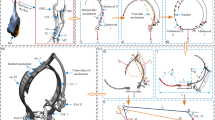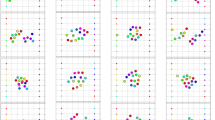Abstract
Technology for the capturing of space target is very important for on-orbit servicing. In order to assure the task is accomplished successfully, ground experimentations are required for the verification of the planning and control algorithms of space robotic system before it is launched. In this paper, an experiment concept is used, which is a hybrid approach, i.e. it combines the mathematical model with the physical model. The key issues of the concept are dynamic emulation and kinematic equivalence, in which the behaviors of the space robotic system are calculated by its dynamic equations. The motion of its end-effector and the space target is realized by two industrial robots. According to different observation spots, two modes of capturing process are emulated: one is observed from the inertial frame, the other is from the space base. Based on the concept proposed above, a ground experiment system is set up, which is composed of two industrial robots, a set of global visual system and five industrial computers. Using the system, algorithms of space robot of any geometry and mass properties can be tested. As an example, the autonomous trajectory planning algorithm is verified by the experiment of capturing a moving target. Moreover, a real-time 3D simulation system is developed to emulate the capturing process in 3D space. Numeric simulation and experiment results show that the ground system is effective in evaluating the planning and control algorithms of space robot.
Similar content being viewed by others
References
Zimpfer, D., Spehar, P.: STS-71 Shuttle/Mir GNC Mission Overview. Adv. Astronaut. Sci. 93, American Astronautical Society, San Diego, CA, pp. 441–460 (1996)
Brunner, B., Hirzinger, G., Landzettel, K., et al.: Multisensory Shared Autonomy and Tele-Sensor-Programming-Key Issues in the Space Robot Technology Experiment ROTEX. IEEE/RSJ Int. Conf. on Intelligent Robots and Systems (IROS), Yokohama, pp. 2123–2139 (July, 1993)
Visentin, G., Brown, D.L.: Robotics for geostationary satellite service. Robot. Auton. Syst. 23, 45–51 (1998)
Settelmeyer, E. Hartmann, Landzettel, R.K., et al.: The Experimental Servicing Satellite ESS”, In: 21th, ISTS Conference, Omiya, Japan (1998)
DLR Web, Technology Satellite for demonstration and verification of Space systems, available: http://www.robotic.dlr.de/TECSAS
Inaba, N., Oda, M.: Autonomous Satellite Capture by a Space Robot. In: IEEE Int. Conf. Robot. Autom., San Francisco, CA., pp. 1169–1174 (April 2000)
Oda, M., Kibe, K., Yamagata, F.:vETS-VII, Space Robot In-Orbit Experiment Satellite. In: IEEE Int. Conf. Robot. Autom., Minneapolis, USA, pp. 739–744 (April 1996)
Umatani, Y., Yoshida, K.: Experimental Study of a Two Dimesional Free-Flying Robot Satellite Model. In: Proceedings of the Nasa Conference on Space Telerobotics, Pasadena, CA (January 1989)
Koningstein, R., Cannon, R.H.: Experiments with model-simplified computed torque manipulator controllers for free-flying robots. J. Guid. Control Dyn. 18(6), 1387–1391 (1995)
Ullman, M.A., Cannon, R.H., Rock, S.M.: A Modular System Architecture for Multi-Manipulator Free-Flying Space Robots. In: IEEE Proceedings of the International Symposium on Intelligent Control, Chicago, IL, pp. 90–97 (Aug. 1993)
Robertson, A., Inalhan, G., How, J.P.: Spacecraft Formation Flying Control Design for the Orion Mission. In: AIAA Guidance, Navigation, and Control Conference and Exhibit, Potland, OR, Vol. 3, pp. 1562–1575 (Aug. 1999)
Sato, Y., et al.: Micro-G Emulation System Using Constant-Tension Suspension for a Space Manipulator. In: IEEE Proceedings of the International Conference on Robotics and Automation, Sacramento, CA, 1893–1900 (April 1991)
Xu, Y.S., Benjamin Brown, H., Friedman, Jr.: Control system of the self-mobile space manipulator. IEEE Trans. Control Syst. Technol. 2(3), 207–219 (Sep. 1994)
White, G.C., Xu, Y.: Active vertical-direction gravity compensation system. IEEE Trans. Instrum. Meas. 43(6), 786–792 (Dec. 1994)
Watanabe, Y., Araki, K., Nakainura, Y.: Microgravity Experiments for a Visual Feedback Control of a Space Robot Capturing a Target. In: Proceedings of the IEEE/RSJ Inti. Conference on Intelligent Robots and Systems, Victoria, BC, Canada pp. 1993–1998 (Oct. 1998)
Sawada, H., Ui, K., Mori, M., et al.: Micro-gravity experiment of a space robotic arm using parabolic flight. Adv. Robot. 18(3), 247–267 (2004)
Spofford, J.R., Akin, D.L.: Redundancy control of a free-flying telerobot. J. Guid. Control Dyn. 13(3), 515–523 (May 1990)
Carignan, C.R., Akin, D.L.: The reaction stabilization of on-orbit robots. IEEE Control Syst. Mag. 20(6), 19–23 (2000)
Menon, C., Busolo, S., Cocuzza, S., et al.: Issues and new solutions for testing free-flying robots. IAC-04-IAF-1.J.5 1–11 (2004)
Iwata, T., et al.: Ground & Flying Testbed for the 2nd Generation Space Robot. In: Proceedings of the i-SAIRAS’90, Kobe, Japan (1990)
Shimoji, H., et al.: Simulation System for a Space Robot Using 6 Axes Servos. In: Proceedings of the XIth IFAC Symposium of Automatic Control in Aerospace (1989)
Dubowsky, S., Durfee, W., Corrigan, T., et al.: A Laboratory Testbed for Space Robotics: The VES II. In: Proceedings of IEEE conference of Robots and Systems (IROS), pp. 1562–1569 (1994)
Agrawal, S.K., Hirzinger, G., Landzettel, K., et al.: A new laboratory simulator for study of motion of free-floating robots relative to space targets. IEEE Trans. Robot. Autom. 12(4), 627–633 (1996)
Ma, O., Wang, J., Misra, S., et al.: On the validation of SPDM task verification facility. J. Robot. Syst. 21(5), 219–235 (2004)
Umetani, Y., Yoshida, K.: Resolved motion rate control of space manipulators with generalized Jacobian matrix. IEEE Trans. Robot. Autom. 5(3), 303–314 (June 1989)
MSC software, ADAMAS/View user’s guide, available: http://www.mscsoftware.com
Acknowledgements
We would like to thank Dr P. F. Huang and Dr Y. Liu for their valuable suggestion on the paper. This work is supported by Chinese High-Tech Program in Aerospace.
Author information
Authors and Affiliations
Corresponding author
Rights and permissions
About this article
Cite this article
Xu, W., Liang, B., Xu, Y. et al. A Ground Experiment System of Free-floating Robot For Capturing Space Target. J Intell Robot Syst 48, 187–208 (2007). https://doi.org/10.1007/s10846-006-9087-8
Received:
Accepted:
Published:
Issue Date:
DOI: https://doi.org/10.1007/s10846-006-9087-8




